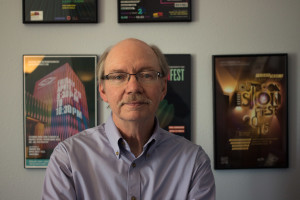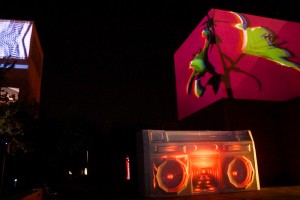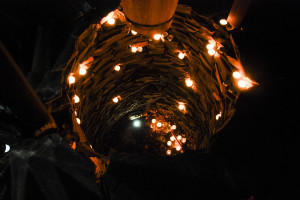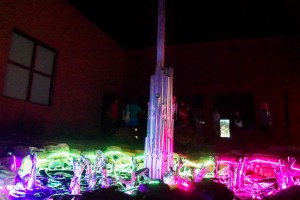Tags
Related Posts
Share This
Outdoor Vision Fest ’16

Terry Borst is the screenwriting professor and OVF executive producer at Santa Fe University of Art and Design. Photo by Richard Sweeting
Marking the end of the Spring semester, Santa fe University of Art and Design’s annual Outdoor Vision Fest approaches on April 29 with a variety of visual and physically interactive art displays. From past caged performers to creative film projection to edible symbols of the written word, OVF is an exhibition created by and for nearly every department at SFUAD. Jackalope Magazine interviewed OVF Executive Producer and screenwriting professor Terry Borst via email about the upcoming event.
Jackalope Magazine: Can you start by describing to us what Outdoor Vision Fest is? How many years has Outdoor Vision Fest been an event on the Santa Fe University of Art and Design campus?
Terry Borst: Outdoor Vision Fest® (OVF®) began as an experimental collaboration between The Film School and Graphic Design (when it still included Digital Arts) in Spring 2011. Before it debuted, Photography and Studio Arts began contributing installations, and the rest—as they say—is history. Outdoor Vision Fest is an annual one-night-only on-campus event that showcases the creativity of students developing cutting-edge media installations that break down barriers between artistic disciplines. Use of Projection media and creation of an outdoor experience are really the only requirements for OVF installations, so everything from performance to motion graphics to multi-channel video to sculpture to sound-and-picture that interact with the audience may comprise a piece.

Previous OVF events draw hundreds to the campus. Photo by Luke Montavon
JM: What kind of outside participation is involved? I’ve heard that Meow Wolf is a regular participant in OVF. What role do they, or any other outside involvement, play?
TB: Meow Wolf has never participated in OVF. One can actually argue that some of OVF’s DNA is in Meow Wolf, as several current students and OVF alumni have contributed to the design and development of Meow Wolf’s new “House of Eternal Return.” We’re very proud of the fact that OVF is 100 percent student-driven. In OVF2012, we also brought in students from Laureate’s university in Bilgi, Turkey to contribute an installation. This year, we’re pleased that a couple of OVF alums are returning to contribute to installations, and we’re also anticipating a special guest artist to come in and be accompanied by student artists in their contribution. But it’s really important to recognize that OVF is owned by students. And the amazing thing has been how many OVF installations have then been scooped up for exhibition or further development by a variety of galleries, events, and venues literally around the Western Hemisphere.
JM: How did the students get involved? Did they volunteer or were they selected by staff? Are there any restrictions to who can participate in OVF?

“Pray for Nepal Victims” was an installation at a previous OVF. Photo By: Cydnie Smith-McCarthy
TB: The vast majority of installations are developed in classes specifically built to “pipeline” work to OVF. Professors Brad Wolfley and Tom Miller mentor the development of these installations in some of their most cutting-edge classes. In past years, Digital Arts also developed installations for the event. Contributing faculty Jason Goodyear (CMP) and Jocelyne Danchick (PAD) have also mentored installations out of their departments. Some of the installations are perennials: for example, animated OVF logos… Twitter and Instagram feeds, etc. I should also mention our annual collaboration with Frontier, which results in an installation that spotlights the top 20 pieces entered into the competition, which this year is “microNARRATIVE.” We don’t allow just anyone to “set up shop” for a night and project: that would be unfair to the students who develop installations for many weeks, rehearse for multiple nights, and carefully site their installations to complement and co-exist with other installations. OVF is a show—not an amateur hour. [It is] student-owned with just a few faculty mentors to help guide it. My role is to executive-produce the event, and make sure OVF is successful for student artists and for the audience.
JM: What do you hope is accomplished this year that has never been done before?
TB: We are placing greater emphasis on installations that are reactive to the audience in some way. How can the audience interact with the media, and how does this—in turn—evolve and drive the experience?
JM: What setup are you most looking forward to seeing come to life this year? Why?
TB: Too early to know yet! Part of the excitement of OVF is the “high-wire” act of its plethora of installations. This is a live event, and sometimes things don’t work or behave unexpectedly. But generally two to three installations emerge each year that become the “masterpieces” of the one-night event. I’m sure we’re going to create new memories this year.
JM: Lastly, what message do you hope attendees take from this experience?

“Reflective Escapism” by Christopher Stahelin between Tipton Hall and The Marion Center from a previous OVF. Photo by Luke Montavon
TB: First, we’d love to have everyone nominate OVF as Best (Event) of Santa Fe. The deadline for nominations with the Santa Fe Reporter is March 31. Second, #ovf2016 is our hashtag for Twitter, Instagram, etc — so we encourage the “chatter” to get started; and, Outdoor Vision Fest is on Facebook. Go like the page if you haven’t already! Finally, students should be taking away from OVF the knowledge that their work and their creativity is of notable caliber — competitive with other artists and creators of professional standing. And for the larger community: this is an incredible opportunity to 1) enjoy and touch art in a way they can’t normally do in an art gallery or museum; and 2) see the talent level of students at SFUAD — with the possibility that some of the attendees may be able to hire or commission these students in the future (and this has already happened!).
Outdoor Vision Fest of 2016 will begin 6 p.m. April 29.
This interview has been edited for style and length.






 Jackalope Magazine is the student magazine of Santa Fe University of Art and Design. Building on the interdisciplinary nature of our education, we aim to showcase the talent of our university and character of our city.
Jackalope Magazine is the student magazine of Santa Fe University of Art and Design. Building on the interdisciplinary nature of our education, we aim to showcase the talent of our university and character of our city.
0 Comments
Trackbacks/Pingbacks